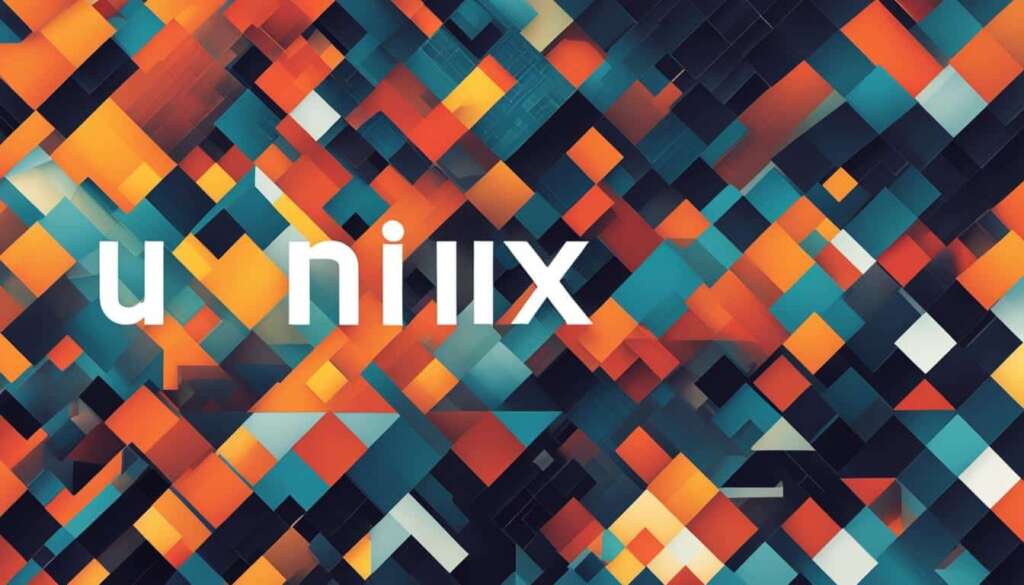Table of Contents
Welcome to our article on Unix, the highly versatile and powerful operating system that has been driving the digital world since the 1960s. In this section, we will provide you with a concise introduction to what Unix is and its key features.
Unix is an operating system renowned for its stability and flexibility. It is widely used in servers, desktops, and laptops, making it a fundamental part of today’s technology landscape. At its core, Unix is a multi-user and multi-tasking system that enables multiple users to access and interact with the system simultaneously.
One of Unix’s distinguishing features is its graphical user interface (GUI), which provides a user-friendly experience similar to Microsoft Windows. This allows users to navigate and interact with the system easily, making it accessible to both beginner and advanced users.
There are various versions of Unix available, each with its own unique features and characteristics. Some popular variations include Sun Solaris, GNU/Linux, and MacOS X. One notable version is Red Hat Enterprise Linux (RHEL), widely used in academic institutions and enterprise environments.
The Unix operating system consists of three major components – the kernel, the shell, and the programs. The kernel is responsible for resource allocation and system call handling, ensuring smooth operation and efficient utilization of system resources. The shell acts as an interface between users and the kernel, allowing users to enter commands and execute various operations. Users can customize their own shell to suit their preferences and requirements. The programs, also known as utilities, are a collection of tools that perform specific tasks and enhance the functionality of the system.
Unix treats everything as either a file or a process, leading to a hierarchical file system structure with the root directory at the top. By opening an Unix terminal, users can enter commands and interact directly with the system, making it a powerful and flexible environment for various tasks and operations.
History of Unix
Unix, an operating system with a rich history, was developed in the late 1960s through collaborative efforts between Bell Labs, General Electric, and the Massachusetts Institute of Technology. Originally conceived as an interactive time-sharing system called Multics, the project faced setbacks when Bell Labs withdrew its support. However, this setback paved the way for Ken Thompson and Dennis Ritchie to forge ahead and create the Unix operating system we know today.
A noteworthy aspect of Unix’s development is that it was written in the C programming language, a novel choice at the time. This decision would have far-reaching consequences, as the C programming language eventually became one of the most widely used languages for system software development.
During the late 1970s and early 1980s, Unix gained significant popularity in both academic and commercial circles. The Computer Systems Research Group at the University of California, Berkeley, developed Berkeley Software Distribution (BSD), which was one of the earliest Unix distributions.
One of the defining characteristics of Unix is its philosophy, which prioritizes modularity and reusability. This philosophy has had a profound impact on the field of software development, inspiring generations of programmers to create elegant and efficient solutions.
Unix Features and Functionality
Unix is a modular operating system known for its simplicity and powerful tools. It offers a range of features that contribute to its flexibility, portability, and security.
Kernel:
The kernel is at the core of the Unix operating system. It provides essential services such as memory management, task scheduling, and file management. By efficiently allocating system resources, the kernel ensures the smooth operation of Unix.
Shell:
The shell serves as the interface between the user and the kernel. It allows users to enter commands and execute various operations on the system. Unix offers different shell options, including the popular Bourne shell (sh), C shell (csh), and bash (Bourne-again shell).
File System:
Unix employs a hierarchical file system that organizes files into directories. This structure allows for efficient file management and easy navigation. The root directory serves as the top-level directory, from which all other directories and files stem.
Core Utilities:
Unix includes a set of core utilities that perform specific operations, contributing to the system’s functionality. These utilities encompass tasks such as file creation, deletion, system configuration, and text processing. They form the foundation of Unix’s versatile toolset.
Multitasking and Multiuser Support:
Unix supports multitasking, enabling multiple processes to run concurrently. This feature allows users to execute multiple programs simultaneously, increasing overall system efficiency. Additionally, Unix provides robust multiuser support, allowing multiple users to access and interact with the system concurrently, while maintaining data security and integrity.
Shell Scripting:
Unix provides a powerful shell scripting language, allowing users to automate tasks and streamline workflows. Shell scripts are sequences of commands that can be executed as scripts, enhancing productivity and simplifying complex operations.
Security:
Unix prioritizes security through various mechanisms. It implements file permissions, enabling users to control access and modification rights for files and directories. User accounts are carefully managed, ensuring that only authorized individuals can interact with the system. Unix also incorporates robust network security features, protecting against unauthorized access and potential threats.
Portability:
One of Unix’s notable characteristics is its portability. Unix can run on a wide range of hardware platforms, making it adaptable and accessible across different devices and architectures. This portability contributes to Unix’s widespread use and popularity.
Unix Features and Functionality
| Feature | Description |
|---|---|
| Kernel | Provides memory management, task scheduling, and file management |
| Shell | Serves as the interface between the user and the kernel |
| File System | Organizes files into a hierarchical structure |
| Core Utilities | Performs essential system operations |
| Multitasking and Multiuser Support | Enables concurrent execution of processes and simultaneous user access |
| Shell Scripting | Allows automation of tasks through shell scripts |
| Security | Implements file permissions, user accounts, and network security features |
| Portability | Capable of running on a variety of hardware platforms |
Unix offers a range of features and functionality that make it a reliable and versatile operating system. From its modular structure to its robust security measures, Unix continues to be a preferred choice across various industries.
Unix Variants and Licensing
Unix is a versatile operating system that has resulted in various variants with different licensing models. Some Unix variants are proprietary and require a licensing fee, while others are open-source and freely available. Let’s explore some of the popular Unix variants and their licensing characteristics.
Proprietary Unix
Proprietary Unix variants are developed and distributed by specific vendors who charge a licensing fee for their use. These variants often come with additional features, technical support, and compatibility guarantees. Some examples of proprietary Unix variants include:
- IBM AIX
- Oracle Solaris
- HP-UX
Open-Source Unix
Open-source Unix variants are freely available and allow users to access, modify, and distribute the source code. These variants have vibrant and enthusiastic communities that contribute to their development and improvement. Some popular open-source Unix variants are:
- Linux
- FreeBSD
- OpenBSD
Linux, in particular, has gained significant popularity and runs on various devices, including desktops, servers, and mobile devices. The open-source nature of Linux has contributed to its widespread adoption and continuous evolution.
Unix-Like Operating Systems
In addition to the specific Unix variants, there are also Unix-like operating systems that have some relation to Unix. These operating systems may not strictly adhere to the Unix specifications but exhibit Unix-like features and behaviors. Unix-like operating systems include both proprietary and open-source variations. They provide users with Unix-like functionality and often offer compatibility with Unix applications. Some examples of Unix-like operating systems are:
- GNU/Linux
- MacOS
- Chrome OS
Single UNIX Specification and Unix Trademark
The Single UNIX Specification (SUS) is a standard that defines the requirements for a conforming Unix-like system. It ensures compatibility and interoperability between different Unix-like operating systems. The Unix trademark, on the other hand, is owned by The Open Group, an industry consortium. The Open Group certifies and brands Unix implementations that meet their specifications, ensuring compliance with the Unix standards.
Unix Variants in Use
Unix variants continue to be widely used in various domains. They have a strong presence in enterprise computing, scientific research, and web servers. The stability, security, and robustness of Unix make it a preferred choice for critical systems that require high reliability and performance. Additionally, the availability of a wide range of software and tools for Unix variants makes them essential for specific use cases and industries.

| Unix Variant | Licensing Model |
|---|---|
| IBM AIX | Proprietary |
| Oracle Solaris | Proprietary |
| HP-UX | Proprietary |
| Linux | Open-Source |
| FreeBSD | Open-Source |
| OpenBSD | Open-Source |
Unix Advantages
Unix offers several advantages that make it a preferred choice for many users and organizations. Let’s explore some of its key benefits:
- Stability: Unix is renowned for its stability and reliability. It can run for long periods without requiring frequent reboots, ensuring uninterrupted operation.
- Security: Unix incorporates a robust security model, providing strong protection for confidential data and sensitive information. Features such as file permissions, user accounts, and network security help safeguard against unauthorized access and breaches.
- Scalability: Unix is highly scalable, capable of handling large workloads and accommodating increasing demands. It can efficiently scale up or scale out to meet the needs of growing businesses or expanding data requirements.
- Flexibility: One of Unix’s notable strengths is its flexibility. It can be customized and tailored to suit specific needs and requirements. Users have the freedom to configure and personalize the system to achieve optimal performance and productivity.
“Unix’s stability, security, scalability, and flexibility make it a reliable choice for a wide range of applications and industries.”
Furthermore, Unix offers a powerful and efficient command-line interface. This interface allows users to interact directly with the system through commands, providing quick access to an extensive range of features and capabilities. The command-line interface enables advanced scripting, automation, and precise control, making it a preferred choice for experienced users and system administrators.
| Advantage | Description |
|---|---|
| Stability | Unix systems can run for extended periods without requiring reboots, ensuring uninterrupted operation. |
| Security | Unix incorporates a robust security model with strong measures to protect against unauthorized access and data breaches. |
| Scalability | Unix can handle large workloads and smoothly scale to accommodate growing demands. |
| Flexibility | Unix can be customized and tailored to specific needs and requirements. |
| Command-Line Interface | Unix provides a powerful and efficient command-line interface for advanced control and automation. |
Overall, Unix’s advantages in terms of stability, security, scalability, flexibility, and its robust command-line interface make it an attractive choice for individuals and organizations seeking a reliable and versatile operating system.
Unix Disadvantages
Despite its advantages, Unix has some drawbacks that users should consider before adopting it as their operating system of choice.
1. Complexity
Unix can be complex and difficult to learn, especially for users who are accustomed to graphical user interfaces. The command-line interface and the need to use specific commands and syntax can be overwhelming for beginners.
2. Cost
Some Unix systems, particularly proprietary versions, can be expensive to implement and maintain. This cost factor may limit the accessibility and affordability of Unix for certain users or organizations.
3. Lack of Standardization
Unix lacks standardization, with various versions and variants available. This can make compatibility between different Unix systems challenging. Users may encounter issues when trying to run software or transfer files between different Unix distributions.
4. Limited Software Availability
While Unix has a wide range of software available, some specialized software may not be developed or fully supported for Unix systems. This limitation in software availability may restrict the options for certain applications or industries.
5. Steep Learning Curve
Unix requires a certain level of technical expertise to effectively use and manage. Novice users may find the learning curve quite steep, as they must familiarize themselves with the command-line interface, Unix-specific commands, and system configurations.
Despite these disadvantages, Unix continues to be widely used in various domains due to its stability, security, and flexibility.
Unix Disadvantages Comparison
| Disadvantage | Explanation |
|---|---|
| Complexity | Unix can be complex and difficult to learn for users accustomed to graphical user interfaces. |
| Cost | Some Unix systems, particularly proprietary versions, can be expensive to implement and maintain. |
| Lack of Standardization | Unix lacks standardization, making compatibility between different Unix systems a challenge. |
| Limited Software Availability | Some specialized software may not be available or fully supported for Unix systems. |
| Steep Learning Curve | Unix requires a certain level of technical expertise, resulting in a steep learning curve for novice users. |
The Future of Unix
Unix and its variants continue to play a significant role in various systems, including workstations, servers, and supercomputers. However, the dominance of Unix has faced challenges in recent years, particularly with the rise of Linux, an open-source Unix-like operating system. Linux has gained immense popularity and has established a strong presence in data centers and cloud platforms.
The usage of traditional Unix systems has witnessed a decline, mainly due to factors such as the widespread adoption of x86-based alternatives and the push for IT modernization strategies. Organizations have increasingly sought to modernize their infrastructure, often leading them away from traditional Unix deployments.
Nevertheless, Unix still holds relevance and remains the preferred choice for specific use cases. Industries such as finance, government, and telecommunications heavily rely on Unix for data center application support, cloud security, and vertical-specific software. These sectors benefit from the robustness, scalability, and security of Unix systems, making them reluctant to fully abandon their reliance on Unix.
While Unix server sales may experience a gradual decline, Unix applications are expected to continue fulfilling critical roles in various sectors. The future of Unix, therefore, lies in a balance between its decline in general usage and its continual relevance in niche industries.
Unix Applications and Servers
Unix applications continue to serve essential functions and contribute to the smooth operations of numerous industries. The stability, security, and flexibility of Unix make it an ideal choice for development and deployment of critical applications. The following table provides examples of key industries and their reliance on Unix applications:
| Industry | Unix Applications |
|---|---|
| Finance | High-performance trading systems, risk management software |
| Government | Secure information systems, citizen services platforms |
| Telecommunications | Network monitoring tools, billing systems |
Unix servers play a crucial role in supporting these applications and facilitating the operations of various industries. While the overall market share of Unix servers may decline, their importance in specific sectors remains unchanged:
Unix servers continue to serve as reliable, robust, and secure platforms for critical applications in finance, government, and telecommunications. The preference for Unix in these sectors stems from its ability to handle high workloads, maintain data integrity, and ensure stringent security measures, making it indispensable for industry-specific operations.
The future of Unix, therefore, entails a nuanced landscape. While its general usage may undergo a gradual decline, Unix applications and servers will persist as vital components across various sectors, ensuring the continued relevance of Unix in specific use cases.
Difference between Unix and Linux
Unix and Linux are closely related, with Linux being a Unix clone. However, there are some key differences between them.
Linux is an open-source operating system, with its source code freely available to users. This means that anyone can access and modify the code to suit their needs. In contrast, Unix is typically a proprietary operating system, with limited access to its source code.
Another difference lies in the user interface. Linux supports both graphical user interfaces (GUI) and command-line interfaces (CLI), providing users with flexibility in how they interact with the system. Unix, on the other hand, primarily relies on a command-line interface, which requires users to enter commands to perform tasks.
The file systems supported by Linux and Unix also vary. Linux supports a wide range of file systems, including ext4, xfs, and btrfs, offering users more options for organizing and managing their data. Unix, on the other hand, typically uses file systems such as UFS or ZFS, which are designed for maximum stability and performance.
When it comes to hardware support, Linux has the advantage. It is compatible with a wide range of hardware platforms, from personal computers to mobile devices and embedded systems. Unix, on the other hand, was originally designed for mainframe computers and may have limited hardware compatibility.
In summary, while Unix and Linux share similarities, such as their command-line heritage and similar file system principles, their differences in source code availability, user interface, file systems, and hardware support make each suitable for different use cases.
FAQ
What is Unix?
Unix is an operating system developed in the 1960s that is known for being stable, multi-user, and multi-tasking. It can be used on servers, desktops, and laptops and has a graphical user interface similar to Microsoft Windows.
What are the different types of Unix?
There are many versions of Unix, including Sun Solaris, GNU/Linux, and MacOS X. One popular version used by academic institutions is Red Hat Enterprise Linux (RHEL).
What are the components of the Unix operating system?
The Unix operating system has three main parts: the kernel, the shell, and the programs. The kernel is responsible for allocating resources and handling system calls. The shell acts as an interface between the user and the kernel and can be customized by users. The programs are the various tools and utilities that help users interact with the system.
Who developed Unix?
Unix was developed in the late 1960s by Bell Labs, General Electric, and the Massachusetts Institute of Technology. It was originally intended to be an interactive time-sharing system called Multics, but Bell Labs continued the development and created the Unix operating system.
What is the difference between Unix and Linux?
Linux is an open-source operating system that was inspired by Unix and is considered a Unix clone. While Unix is typically a proprietary operating system, Linux’s source code is freely available to users. Linux also has broader hardware support compared to Unix, which was originally designed for mainframe computers.
What are the advantages of using Unix?
Unix is known for its stability, reliability, and scalability. It has a robust security model and offers a powerful command-line interface for efficient system interaction. Unix is also highly customizable and flexible to suit different needs.
What are the disadvantages of Unix?
Unix can be complex and difficult to learn, especially for users who are used to graphical user interfaces. Some Unix systems can be expensive, particularly proprietary versions. Unix also lacks standardization, making compatibility challenging at times. Additionally, certain specialized software may not be available for Unix systems, and it requires a certain level of technical expertise.
What is the future of Unix?
While Unix usage has declined in recent years, particularly with the rise of Linux and IT modernization strategies, Unix is expected to continue being used in certain sectors such as finance, government, and telecommunications. The future of Unix may involve a gradual decline, but complete abandonment is unlikely to happen soon.












